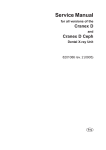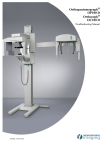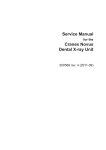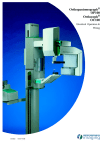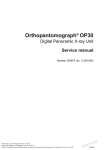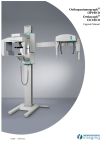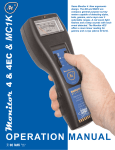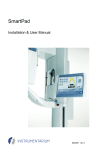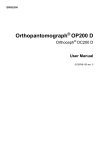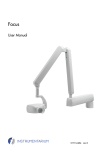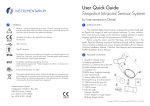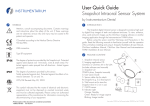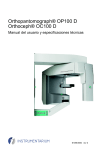Download 63515_OP100D_OC100D_Service Programs
Transcript
Orthopantomograph® OP100 D Orthoceph® OC100 D Service Program Manual For sw. 1.4.11 and sw. 1.4 13 09/2002 64515-4AA Copyright © 2002 by Instrumentarium Imaging Documentation, trademark and the software are copyrighted with all rights reserved. Under the copyright laws the documentation may not be copied, photocopied, reproduced, translated, or reduced to any electronic medium or machine readable form in whole or part, without the prior written permission of Instrumentarium Imaging. Orthopantomograph® and Orthoceph® are registered trademarks of Instrumentarium Corporation. U.S. patents 4,641,336; 5,016,264; 5,425,065 and 5,444,754. German patent 4,344,745. Orthopantomograph® OP100 D and Orthoceph® OC100 D comply with UL and C-UL (File E218408). The original language of this manual is English. Instrumentarium Imaging reserves the right to revise this publication from time to time and to make changes in the content of it without obligation to notify any person of such revision or changes. Manufactured by Instrumentarium Imaging P.O. Box 20 FIN-04301 Tuusula FINLAND Tel. +358 10 394 6500 Fax. +358 10 394 6501 E-mail: [email protected] Internet: http://www.InstrumentariumImaging.com Table of Contents 1 Service programs ................................................................................................ 1 1.1 1.2 1.3 1.4 1.5 2 General..................................................................................................................... 1 Exhibition mode ...................................................................................................... 2 SR: general purpose test programs .......................................................................... 3 SR: movement test programs................................................................................... 4 How to use “sr” features.......................................................................................... 4 Service program “SR” features......................................................................... 7 2.1 2.2 2.3 2.4 2.5 2.6 2.7 2.8 2.9 2.10 2.11 2.12 2.13 2.14 2.15 64515-4AA SR 70 SCR: scroll eeprom contents ........................................................................ 7 SR 74 IOC: cpu input output check......................................................................... 8 SR 75 EPS: exposure without movements ............................................................ 15 SR 76 PUP: warming-up procedure for tubehead ................................................. 15 SR 77 PRH: Preheat automatic adjustment ........................................................... 17 SR 78 FRE: AEC frequency display ..................................................................... 18 SR 79 SUP: line voltage display............................................................................ 18 SR 80 RO-: rotation test without exposure............................................................ 19 SR 81 LI-: linear movement test without exposure............................................... 19 SR 82 CE-: ceph movement test without exposure ............................................... 20 SR 83 RO=: rotation test with exposure & acceleration ....................................... 21 SR 84 LI=: linear movement test with exposure & acceleration........................... 22 SR 86 ROC: rotation test with exposure & constant speed................................... 23 SR 87 LIC: linear movement test with exposure & constant speed ...................... 23 SR 89 COP: country options ................................................................................. 24 Instrumentarium Imaging i ii Instrumentarium Imaging 64515-4AA 1 Service programs 1 Service programs 1.1 General Orthopantomograph® OP100 D is software controlled diagnostic panoramic dental x-ray equipment for producing high quality digital images of dentition and TM-joints. Software is divided into two parts. User programs (“Pr”) are accessible by the user and they have features for configuring the unit for daily use and for changing technique factors to optimize image quality. Maintenance & Service programs (“Sr”) are for technical people for installation and service. Tools are required to access “Sr” programs. This manual covers the features of the “Sr” programs OP100 D software version 1.4.11. Please refer to the OP100 D User Program Manual V1.4.11 for “Pr” program features. Letters “Pr” or “Sr” in the kV display indicate that the unit is in the programming mode. Numbers 50 to 68 and 70 to 89 in the mA display indicate the actual numeric code for each program. Letters in the exposure time display indicate the mnemonic explanation for each program, to remind the user of the actual numeric program code meaning. After you have set OP100 D for Service mode, different service programs can be selected by pushing up and down keys, until the desired service program code appears on the display. The display indicates the service program in the following form: 64515-4AA Instrumentarium Imaging 1 1 Service programs Display Value(s) Description Sr The unit is in the service mode, and the serviceman is able to use the service programs to test the unit. mA 70 - 89 Indicates the actual numeric code for respective service program. View the functions with up and down keys and select with OK key. s Scr, IOC, EPS, PUP, Prh, FrE, SUPro-, LI-, CE-, ro=, LI=, roc, LIc, COP Indicates the alphanumeric short form for the explanation of the service program, to remind the serviceman what the numeric program code means. kV The displayed service program can be activated by pushing the OK key. After activating the service program the test starts. In programs which require movements and / or exposure, the test starts when pushing the exposure button. Pas / Err After completing the test the text “PAS” in time display indicates that the unit passed the test, or respective failure code “Err” indicates that the test failed. Repeat the service program or select a new one. 1.2 Exhibition mode From software version 1.2.07, the OP100D does not emit x-rays, when the OP100D has been set for exhibition mode. Exhibition mode is selected, when CPU option switch S2 is set “ON” or option jumper X 11 is set to “ON”. 2 Instrumentarium Imaging 64515-4AA 1 Service programs 1.3 SR: general purpose test programs GENERAL PURPOSE TESTS REFERENCE TABLE SCROLL EEPROM CONTENTS Sr 70 cr Scroll the failure code counters and the exposure counters of the CPU EEPROM. INPUT / OUTPUT Sr 74 IOC Operation of CPU input and output signals is monitored and displayed with control panel’s LED’s. EXPOSURE WITHOUT MOVEMENTS Sr 75 EPS Exposure without imaging movements (the stepping motors don’t operate). Sr 76 PUP WARMING UP SEQUENCE Sr 77 Prh PREHEAT ADJUSTMENT Tube warming up procedure. Automatic preheat adjustment. AEC FREQUENCY MONITORING Sr 78 FrE Sr 79 SUP Program displays AEC Board frequencies in time display during the exposure or standby. LINE VOLTAGE DISPLAY Displays the line voltage continuously. COUNTRY OPTIONS Sr 89 COP 64515-4AA Remote exposure only, Disable Ceph Collimator, Disable AEC, Free kV-mA values, Select ceph mA, Ortho Zone, Ortho TMJ and Ortho Trans Instrumentarium Imaging 3 1 Service programs 1.4 SR: movement test programs MOVEMENT TESTS REFERENCE TABLE Sr 80 ro- ROTATION MOVEMENT DYNAMICS Sr 81 LI- LINEAR MOVEMENT DYNAMICS Sr 82 CE- CEPH MOVEMENT DYNAMICS Rotation movement test in two directions, no exposure. Linear movement test in two directions, no exposure. Ceph movement test in two directions, no exposure. ROTATION SMOOTHNESS WITH ACCELERATION Sr 83 ro= Sr 84 LI= Rotation movement exposure test, and rotation / focal alignment verification. LINEAR MOVEMENT SMOOTHNESS WITH ACCELERATION Linear movement exposure test. ROTATION SMOOTHNESS WITH CONSTANT SPEED: Sr 86 roc Sr 87 Lic Rotation movement exposure test, and rotational / focal alignment verification. LINEAR MOVEMENT SMOOTHNESS WITH CONSTANT SPEED: Linear movement exposure test. NOTE Movements without exposure are indicated in time display with “ - “, movements with acceleration with “ = “ and movements with constant speed are indicated with “ c “. 1.5 How to use “sr” features Switch the OP100D power off. Remove the Frankfort light knob located beside the mirror. Open the side doors and remove the mirror cover by undoing the screws. Lift the cover away. Locate the 3-pin connector X10 and a 2-pin jumper under the program memory circuit on the CPU board. Pull out the jumper and insert it to the left pins. OP100D is now in “SERVICE” mode. 4 Instrumentarium Imaging 64515-4AA 1 Service programs NOTE If the jumper is not installed, CPU resets continuously and red LED H2 is blinking while power is on. Begin the programming. Switch the OP100D power on. Wait for a moment. Software version is displayed during the memory check. The display test will run and numbers from 0 to 9 change on the display. Check that all digits are lit. “ Sr 75 EPS “ is displayed. Select one of the “ Sr “ programs. Use up and down keys to view programs , press OK key to select. Make the trouble shooting, adjustments or change settings. Use arrow keys to select option and settings. Follow the guidelines for each “ Sr “ program described in the next chapter. Store any changes to the OP100 D memory. Press OK. “PAS” is displayed and all indicators are lit. The same program, eg. “Sr 75 EPS”, is displayed again. NOTE If the message “Sy 26 EEP” is displayed, the storing of any changes failed. Please contact your dealer. While the OP100 D power is on, you can move between “ Pr “ user program settings and “ Sr “ service program settings, when needed. Press OK for a while. Beep is heard and one of the user programs is displayed, eg. “ Pr 50 LAY “. Make changes and store them with OK. Press OK again for a while. Beep is heard and one of the user programs is displayed, eg. “ Sr 75 EPS “ again. Exit from service programming. Switch OP100 D power off. Reinsert jumper X 10 to the right. Refit the mirror cover and Frankfort light knob. 64515-4AA Instrumentarium Imaging 5 1 Service programs 6 Instrumentarium Imaging 64515-4AA 2 Service program “SR” features 2 Service program “SR” features 2.1 SR 70 SCR: scroll eeprom contents View the CPU parameter memory (EEPROM) contents. This memory stores the failure code counters and cumulative exposure counter values and this information can be used for obtaining OP100D history data. Some failure counters have have non-zero values at the time of installation. This is normal. Select the program “ Sr 70 SCR “ and press OK. View memory contents by pushing the left and right keys. KV display shows the memory location and mA/s displays show the contents, if any. Table shows different parameters stored, typical values are shown in parenthesis: SR 70 SCR: SCROLL MEMORY CONTENTS kVmA (value)s (value) ** Last Failure (Sy) or Error (Er) code number, except Er 40 CPU, Sy 26 EEP and Sy 20 ***. ( no error ) 15 or 47 ** *** Failure code counter for CPU failures: Er 40 CPU, Er 41 CPU and Er 42 CPU (0) 16 or 48 ** *** Failure code counter for line voltage failure Ch 05 *** . (0) 17 or 49 ** *** Failure code counter for wait-state warning Sy 20 ***. ( 0-10 ) 18 or 50 ** *** Failure code counter for tubehead thermal switch Sy 21 Hho. ( 0-2 ) 19 or 51 ** *** Failure code counter for tubehead failure Sy 22 *** (0) 20 or 52***** Failure code counter for inverter failure Sy 23 Inu (0) 21 or 53***** Failure code counter for filament failure Sy 24 FIL (0) 14 or 46 64515-4AA Memory contents(Typical value) Instrumentarium Imaging 7 2 Service program “SR” features SR 70 SCR: SCROLL MEMORY CONTENTS kVmA (value)s (value) Memory contents(Typical value) 22 or 54 ** *** EEPROM write cycle counter. Indicates the total number of write cycles from “Sr” and “Pr” programs written with “OK” key. ( 200+ ) 23 or 55 ** *** Exposure counter value, resetted in program Pr 61 CLC. (0) 24 or 56 ** *** CPU non-resetable total exposure counter . ( 200+ ) 25 or 57 ** *** Number of exposures since last service call. Value can be resetted in program Pr 59 PSE. ( 200+ ) 26 or 58 ** *** Arcing counter. Counts single arcs and after 5 arcs increments Sy 22 *** counter. ( 10+ ) 27 or 59 ** *** Exposure count limit, set in Sr 71 PAy NOTE After 10,000 write cycles to the EEPROM the kV display shows numbers 46 to 59 indicating a new memory bank: 14 -> 46, 15 -> 47 etc. Exit this program. Press OK key again. “ Sr 70 SCR “ is displayed again. Select another program or exit service programs. 2.2 SR 74 IOC: cpu input output check This program is used for checking the state of the CPU inputs and outputs without opening all the covers of OP100D main assemblies. It is useful for trouble shooting CPU input signal problems, eg. the various microswitches and opto couplers. The program shows whether the signal from some particular switch reaches the CPU or not. The output signals are somewhat arbitrary, but the information may be useful in some situations. Select “ Sr 74 IOC “ and press OK. KV display shows “ In “ for input testing and time display shows “ 0 “ for first test, and the respective port. Use arrow keys to select different tests ( 0 to 5 ) and to select input “ In “ or output “ Ou “ test. 8 Instrumentarium Imaging 64515-4AA 2 Service program “SR” features Some of the Program selection LED’s on the Control panel are lit showing the state of the signal port; LED 1 (standard panoramic program) being bit 0 of the port and LED 2 (child panoramic) being bit 1 etc. Use the tables of the input and output signals with the corresponding I/O port and bit. Use CPU Board schematics to follow signals and refer also to other volumes of the Service Manual for various microswitch states. Note that the control panel display will be updated with a delay. This should be understood when interpreting movements and other output signals. Stop the movement by pressing any key to see the correct output status. After testing return to the program viewing level. Press OK key again. “ Sr 74 IOC “ is displayed again. Select another program or exit service programs. Sr 74 IOC, Input test “ In 0 “ Cephalostat and Linear Movements 64515-4AA LED Signal name Description (Status, when LED on) 1 EEDO EEPROM data out. Do not care. 2 cephLIMSW Cephalostat movement detector board.(at start/end position) 3 cephMIDSW Cephalostat movement detector board (in the middle position) 4 LINLIMSW Linear (Y) movement limit switch S16 or S17. Switches are connected in parallel. ( Switch triggered in end position ) 5 LINMIDSW Linear movement middle switch S15. ( Switch triggered ) 6 (IN) Not used, LED not lit 7 (IN) Not used, LED not lit 8 (IN) Not used, LED not lit Instrumentarium Imaging 9 2 Service program “SR” features Sr 74 IOC, Input test “ In 1” Patient Positioning Panel Keys LED Signal name Description (LED lit when key pressed) 1 ZUP Vertical carriage UP button 2 ZDOWN Vertical carriage DOWN button 3 HOME (LEFT) Left patient positioning button, if panel installed on left side 4 HOME (RIGHT) Right patient positioning button, if panel installed on right side 5 PROJTRIG Projector light button 6 PATWARD Posterior layer correction button / Move linear movement away from the column 7 CENWARD Center layer correction button PILWAR Anterior layer correction button / Move linear movement towards the column 8 Sr 74 IOC, Input test “ In 2 “ Mains Voltage, Exposure, Cephalostat, Option LED Signal name Description (LED on) 1 MAINS 110/230 VAC selection on the power supply board. This is the switch S4 or jumper connector depending on board version (110 VAC) 2 EXPSW Exposure switch (pressed) 3 CEPHDOWN DOWN button on the cephalostat (pressed) CEPHUP UP button on the cephalostat (pressed) COL1SW OCD collimator: microswitch S31 (PAN).OP collimator: grounded 6 COL2SW OCD collimator: microswitch S32 ( CEPH) or OP collimator: SQA ( QA Filter ) grounded 7 (IN) Not used, LED not lit 8 OPTIONSW Switch X 11 or S2 on the CPU board. ( Exhibition mode ) 4 5 10 Instrumentarium Imaging 64515-4AA 2 Service program “SR” features NOTE OC100 collimator switches order: QA, PAN, CEPH Sr 74 IOC, Input test “ In 3 “ Generator Signals LED Signal name Description (LED on) 1 MAOK Tube current OK. LED should be off 2 KVOK Tube voltage OK. LED should be off 3 TEMPFAIL Tube head temperature switch (switch opened with Sy 21 Hho error message) 4 TUBEFAIL Tube head high voltage breakdown. (no breakdown) 5 (IN) Not used, LED not lit 6 (IN) Not used, LED not lit 7 (IN) Not used, LED not lit 8 (IN) Not used, LED not lit Sr 74 IOC, Input test “ In 4 “ Movement & Cephalostat LED Signal name Description (LED on) START START button from the left or right patient positioning panel (pressed) SIDE START button from the left side patient positioning panel pressed CEPHL No cephalostat or cephalostat on the left side (ceph on the left) 4 CEPHR No cephalostat or cephalostat on the right side (ceph on the right) 5 (IN) Not used, LED not lit 6 (IN) Not used, LED not lit 7 (IN) Not used, LED not lit 8 (IN) Not used, LED not lit 1 2 3 64515-4AA Instrumentarium Imaging 11 2 Service program “SR” features Sr 74 IOC, Input test “ In 5 “ Remote exposure, Vertical & Rotation Movement LED Signal name Description (LED lit) 1 (IN) Not used 2 (no name) Remote exposure button (pressed) 3 ZMIDSW Vertical carriage height limiting microswitch S 4 (switch triggered at limiting area) 4 ZLIMSW Vertical carriage limit microswitch S 5 (switch triggered at end position) 5 ROT1SW Rotation movement position switch S 11 6 ROT2SW Rotation movement position switch S 12 7 ROT3SW Rotation movement position switch S 13 8 ROT4SW Rotation movement position switch S 14 Sr 74 IOC, Output test “ Ou 0 “ Motor Control Signals LED Signal name Description (LED on) 1 XDIR Not used (stand-by) 2 XENA Not used (stand-by) 3 ROTDIR Rotation movement direction (stand-by) 4 ROTENA Rotation movement enable (stand-by) 5 CASENA Not used (stand-by) 6 CASDIR Not used (stand-by) 7 LINENA Linear movement enable (stand-by) 8 LINDIR Linear movement direction (stand-by) 12 Instrumentarium Imaging 64515-4AA 2 Service program “SR” features Sr 74 IOC, Output test “ Ou 1 “ CPU Board Internal Signals LED Signal name Description (LED lit) 1 EECS Do not care (stand-by) 2 EESK Do not care (stand-by) 3 EEDI Do not care (stand-by) 4 WRDFS Do not care (stand-by) 5 (OUT) Not used (stand-by) 6 (OUT) Not used (stand-by) 7 (OUT) Not used (stand-by) 8 BEEPER CPU board beeper (stand-by) Sr 74 IOC, Output Test “ Ou 2 “ Generator D/A Converter Data LED Signal name Description(LED’s will change all the time) 1 KVMA0 Data bit 0 2 KVMA1 Data bit 1 3 KVMA2 Data bit 2 4 KVMA3 Data bit 3 5 KVMA4 Data bit 4 6 KVMA5 Data bit 5 7 KVMA6 Data bit 6 8 KVMA7 Data bit 7 Sr 74 IOC, Output test “ Ou 3 “ Patient Positioning Panel LED 64515-4AA LED Signal name Description (LED lit) 1 (OUT) Not used (stand-by) 2 (OUT) Not used (stand-by) 3 (OUT) Not used (stand-by) 4 (AEC1) Not used (stand-by) 5 (AEC2) Not used (stand-by) 6 PATLED Patient positioning panel posterior layer correction button LED (no LED) Instrumentarium Imaging 13 2 Service program “SR” features Sr 74 IOC, Output test “ Ou 3 “ Patient Positioning Panel LED 7 CENLED Patient positioning panel center layer button LED (no LED) 8 PILLED Patient positioning panel anterior layer correction button LED (no LED) Sr 74 IOC, Output Test 2 Ou 4 “ Generator Control Signals LED Signal name Description (LED lit) 1 PREHREL Filament enable (stand-by) 2 PREH Preheat (stand-by) 3 RG1 Generator input power relay (stand-by) 4 RG Generator input rectifier capacitor charging resistor bypass (stand-by) 5 EXPON High voltage enable (stand-by) 6 KVMASEL D/A converter select (stand-by) 7 KVMACLK D/A converter clock (stand-by) 8 (OUT) Not used (stand-by) Sr 74 IOC, Output test “ Ou 5 “ Projector Lights, Vertical Movements LED Signal name Description (LED lit) 1 PROJLIT Projector light enable (lights off) 2 RACKDIR Not used (stand-by) 3 RACKENA Not used (stand-by) 4 ZDIR Vertical carriage movement direction (up) 5 ZENA Vertical carriage movement enable 6 (OUT) Not used (stand-by) 7 (OUT) Not used (stand-by) 8 (LASLIT) Not used (stand-by) 14 Instrumentarium Imaging 64515-4AA 2 Service program “SR” features 2.3 SR 75 EPS: exposure without movements WARNING This special program generates x-rays. Exposure without movements. Stepping motors do not operate during the exposure cycle. This program can be used while doing electrical troubleshooting or calibration. User program “ PR 68 INS “ has the same features as this Service program. NOTE When this program is used, the KVOK and MAOK signals are not monitored. Therefore Sy 23 Inu and Sy 24 FIL error codes are not enabled. Only Sy 22 *** error code is monitored. Procedure: Select “ Sr 75 EPS “ and press . Preselected technique factors are displayed. Select the technique factors, kV, mA and exposure time. Make the exposure. Unit can be operated, but there are no imaging movements during the exposure. NOTE If this program is used to align cephalometric beam, make sure that OC100D is positioned in User mode for cephalometric exposures (Program 5 -> ceph collimator -> movement button) before entering this program. After the exposure the unit is ready for additional exposures. Return to the program viewing level. Press key again. “ Sr 75 EPS “ is displayed again. Select another program or exit service programs. 2.4 SR 76 PUP: warming-up procedure for tubehead WARNING This special program generates x-rays. Purpose of this program is to enable testing of a defective tubehead assembly, or warming up procedure of the replacement of tubehead assembly. Procedure: Select program “ Sr 76 PUP “. Make the exposure. OP 100 D exposes with the lowest kV / mA values. 64515-4AA Instrumentarium Imaging 15 2 Service program “SR” features Repeat the exposure. No wait between the exposures is necessary. The next exposure can be taken right after the previous one. kV / mA starts rising automatically from 20 kV / 1 mA, one step after each 3.2 s exposure, until 85kV / 12mA is reached: Sr 76 PUP: kV & mA Feedback Reference Voltages kV mA s (VkVref) (VmAref) 20 1.0 3.2 (1.00 V) (0.24 V) 30 1.0 3.2 (1.50 V) (0.24 V) 40 1.0 3.2 (2.00 V) (0.24 V) 50 1.0 3.2 (2.50 V) (0.24 V) 54 1.0 3.2 (2.70 V) (0.24 V) 57 1.0 3.2 (2.85 V) (0.24 V) 60 1.0 3.2 (3.00 V) (0.24 V) 63 1.0 3.2 (3.15 V) (0.24 V) 66 1.0 3.2 (3.30 V) (0.24 V) 70 1.0 3.2 (3.50 V) (0.24 V) 73 1.0 3.2 (3.65 V) (0.24 V) 77 1.0 3.2 (3.85 V) (0.24 V) 81 1.0 3.2 (4.05 V) (0.24 V) 85 1.0 3.2 (4.25 V) (0.24 V) 85 2.0 3.2 (4.25 V) (0.49 V) 85 2.5 3.2 (4.25 V) (0.61 V) 85 3.2 3.2 (4.25 V) (0.78 V) 85 4.0 3.2 (4.25 V) (0.97 V) 85 5.0 3.2 (4.25 V) (1.22 V) 85 6.4 3.2 (4.25 V) (1.56 V) 85 8.0 3.2 (4.25 V) (1.94 V) 85 10.0 3.2 (4.25 V) (2.43 V) 85 12.0 3.2 (4.25 V) (2.92 V) Complete one exposure by each technique factors listed above. In case of arcing and / or breakdown, start this test from the beginning (by pushing the “OK”-button twice). If an arc or high voltage breakdown occurs in the tubehead during exposure, this program is terminated and an “Err” failure code will appear on the display. 16 Instrumentarium Imaging 64515-4AA 2 Service program “SR” features When the complete Warming-up procedure has been accomplished, a message “PAS” will appear on the time display. If repetitive arcing and/or breakdowns occurred, consult Instrumentarium Imaging Technical Service. NOTE It is also recommended that the OP100D, which has not been used for 3 months or more, should be warmed up with this program. Always run this program after the tube head assembly replacement. Return to the program viewing level. Press OK key again. “ Sr 76 PUP “ is displayed again. After the test set the OP100D for normal operation and make a panoramic exposure (Program 1) with maximum technique factors. 2.5 SR 77 PRH: Preheat automatic adjustment WARNING This special program generates x-rays. Purpose of this program is to make the unit to adjust it’s preheat level of the filament automatically. Procedure: Select the program Sr77Prh and push the exposure button continuously. Unit makes an exposure with 85 kV. Preheat level starts to rise from 0 by increasing preheat reference slowly, and the unit checks the mA level at the same time. The preheat reference data is displayed in the time display. High number indicates low reference. NOTE After the exposure the preheat value which is normally between 190 and 200 appears on the display. When the desired mA level is reached, program terminates the exposure. Press OK to store the current preheat reference into the EEPROM memory. “ PAS “ appears to the time display accordingly after the program has been completed. If “ Err “ was displayed, try again. Return to the program viewing level. Press OK key again. “ Sr 77 PRH “ is displayed again. Select another program or exit service programs. 64515-4AA Instrumentarium Imaging 17 2 Service program “SR” features 2.6 SR 78 FRE: AEC frequency display WARNING This special program generates x-rays. Purpose of this program is to verify the calibrated frequency of the PAN AEC terminal Board by monitoring the AEC frequency and during the exposure. User program “ Pr 68 INS “ has the same features as this program. This program eliminates the need of oscilloscope or frequency counter when adjusting frequency of the AEC. It is also used to calibrate the AEC terminal Board, refer to OP100D Technical Support Manual for more details on AEC calibration. Procedure: Select program “ Sr 78 FrE “. Technique factors 73kV and 12mA should be selected and time display shows ---.--.---. Make exposure and response frequency (signal AECFRQ) from AEC terminal Board appears on time-display (unit kHz). NOTE If there is no filtering (eg. Al calibration tool missing) between THA and CCD sensor, the displayed frequency might increase rapidly resulting to zeros on display. This frequency can be adjusted from the PAN AEC terminal board. Refer to OP100D Technical Support Manual section “AEC Calibration Procedure” for details. Return to the program viewing level. Press OK key again. “ Sr 78 FRE “ is displayed again. Select another program or exit service programs. 2.7 SR 79 SUP: line voltage display Line voltage is monitored by measuring the incoming +25V supply in the Filament Control Board. Measured line voltage is shown on the time display. Procedure: Select program “ Sr 79 SUP “. The display shows the approximate line voltage value: Inaccuracy of Line Voltage Measurement Inaccuracy of Line Voltage Measurement 230 VAC Line 110 VAC Line ± 5 VAC ± 3 VAC 18 Instrumentarium Imaging 64515-4AA 2 Service program “SR” features Return to the program viewing level. Press OK key again. “ Sr 79 SUP “ is displayed again. Select another program or exit service programs. 2.8 SR 80 RO-: rotation test without exposure Purpose of this program is to check that there is enough torque in the rotational movement: the stepping motor and motor control circuit operate properly, there is enough friction and the movement does not slip nor get stuck. Rotation test can be done in clockwise - counterclockwise and vice versa. Procedure: Select program “ Sr 80 ro- “. Movement test is activated by pushing the exposure button. Movement is driven from start to end by varying speed. Then the movement is driven from end to start by constant, slow speed, and at the same time the CPU checks whether the pulse count of the stepping motor remains the same, to detect whether some pulses were lost during accelerative movements. Display shows the actual rotation in degrees, from “ 0º “ to “ 200º “ and back. Note that figure “ 1.5 “ indicates that the motor is loosing pulses during acceleration that correspond to 1.5º rotation, and “ -1.5 “ indicates that the drive mechanics is sliding during braking sequence that correspond to 1.5º rotation. Press OK key. “ PAS “ or “ Err “ message appears to the time display accordingly after the program has been completed. Test tolerance is ± 1 % or ± 2º. If the test failed and “ Err “ was displayed, check the microswitches, friction surface, drive wheel and its tension, stepping motor and its driving circuitry, cable C 13 inside the rotating unit. Repeat the test when needed or return to the program viewing level by pushing OK key again. 2.9 SR 81 LI-: linear movement test without exposure Purpose of this program is to check that there is enough power in the linear movement: the stepping motor and it’s drive operate properly, and the movement does not get stuck. This test can be done in two directions: towards the column and back or vice versa. Procedure: Select program “ Sr 81 LI- “. Enter the program by pushing the OK button untill the unit stops beeping. Movement test is activated by pushing the exposure button. Movement is driven from start to end by varying speed. Then the movement is driven from end to start by constant, slow speed, and at the same time the CPU checks whether the pulse count of the stepping motor remains the same, to detect whether some pulses were lost during accelerative movements. Display shows the actual linear movement travel (in mm) of “ 0 “ to “ 60 “ and back. Note that a figure “ 0.4 “ indicates that the motor is loosing pulses during acceleration that correspond to 0.4 mm travel, and “ -0.4 “ indicates, 64515-4AA Instrumentarium Imaging 19 2 Service program “SR” features that the drive mechanics are sliding during the braking sequence corresponding to the 0.4 mm travel. Press OK key. “ PAS “ or “ Err “ message appears to the time display accordingly after the program has been completed. Test tolerance is ± 2 % or ± 1.2 mm. If the test failed and “Err” was displayed, check the microswitches, alignment of the fly wheel, linear actuator and linear plate, stepping motor and its driving circuitry. Repeat the test when needed or return to the program viewing level by pushing OK key again. 2.10 SR 82 CE-: ceph movement test without exposure Purpose of this program is to check that there is enough power in the ceph movement: the stepping motor and it’s drive operate properly. Procedure: Select program “ Sr 82 CE- “. Enter the program by pushing the OK button untill the unit stops beeping. Movement test is activated by pushing the exposure button. Movement is driven from start to end by varying speed. Then the movement is driven from end to start by constant, slow speed, and at the same time the CPU checks whether the pulse count of the stepper motor remains the same, to detect whether some pulses were lost during accelerative movements. Display shows the actual ceph movement in mm, from “ 0 “ to “ 260 “. Total travel is 260 mm. Note that figure “ 0.5 “ indicates that the motor is loosing pulses during acceleration corresponding to 0.5 mm travel, and “-0.5” indicates that the drive mechanics is sliding during braking sequence corresponding to 0.5 mm travel. Press OK key. “ PAS “ or “ Err “ message appears to the time display accordingly after the program has been completed. Test tolerance is ± 1mm. If the test failed and “ Err “ was displayed, check the microswitches or opto couplers, friction surface, drive wheel and its tension, stepping motor and its driving circuitry. Repeat the test when needed or return to the program viewing level by pushing OK key again. 20 Instrumentarium Imaging 64515-4AA 2 Service program “SR” features 2.11 SR 83 RO=: rotation test with exposure & acceleration CAUTION This special program generates x-rays. Purpose of this program is to check the smoothness of the rotation movement, and that there are no stripes in the image because of vibrations. Procedure: Select program “ Sr 83 ro= “. Enter the program by pushing the OK button untill the unit stops beeping. Maximum technique factors are displayed. Install an x-ray film (in a cardboard sheet or envelope) horizontally on top of the chin support. Mark the film orientation by bending the envelope from the corner. Use some weight over the envelope. Rotate by hand to see that the cassette holder or the tube head assembly does not touch the film. Use technique factors displayed or select new ones. Unit will start about 40 kV lower than this initial setting, raise kV’s and lower again to compensate film density due to the changes in movement speed. 64515-4AA Instrumentarium Imaging 21 2 Service program “SR” features Make the exposure by pushing the exposure button. Process the film and check that there are no sharp stripes. Some vague stripes may be seen. An excellent film is all gray. Repeat the test when needed. Return to the program viewing level by pushing OK key again. 2.12 SR 84 LI=: linear movement test with exposure & acceleration CAUTION This special program generates x-rays. Purpose of this program is to check the smoothness of the linear movement, and that there are no stripes in the image because of vibrations. Procedure: Select program “ Sr 84 LI= “. Enter the program by pushing the OK button untill the unit stops beeping. Initial technique factors, eg. 66/8.0/4 are displayed. Actual values displayed will dedend on the Pr 52 CCO contrast and density settings for imaging program P1. Install a loaded cassette, or envelope test film, vertically on top of the chin support. Notice the tube side. Use tape to secure the cassette. Use technique factors displayed or select new ones. Unit will start about 40 kV lower than this initial setting, raise kV’s and lower again to compensate film density due to the changes in movement speed. Make an exposure by pushing the exposure button. Process the film and check that there are no sharp stripes. Some vague stripes may be seen. An excellent film is all gray. Return to the program viewing level by pushing OK key again. 22 Instrumentarium Imaging 64515-4AA 2 Service program “SR” features 2.13 SR 86 ROC: rotation test with exposure & constant speed CAUTION This special program generates x-rays. Purpose of this program is to check the smoothness of the rotation movement, and that there are no stripes in the image because of vibrations. Procedure: Select program “ Sr 86 roc “. Enter the program by pushing the OK button untill the unit stops beeping. Technique factors 85/12/100 @ 230 VAC (85/8/ 100 @ 110 VAC) are displayed. Light is blinking on time display. Install an x-ray film (in a cardboard sheet or envelope) horizontally on top of the chin support. Mark the film orientation by bending the envelope from the corner. Use technique factors displayed or select new ones. Exposure time is fixed 10 s, the number in time display, eg. “100” is used to set the motor speed. A smaller number corresponds to faster speed and vice versa. Make an exposure by pushing the exposure button. NOTE The exposure will terminate prior to set time if the movement hits the mechanical limit. Process the film and check that there are no sharp stripes. Some vague stripes may be visible. Return to the program viewing level by pushing key again. 2.14 SR 87 LIC: linear movement test with exposure & constant speed CAUTION This special program generates x-rays. Purpose of this program is to check the smoothness of the linear movement, and that there are no stripes in the image because of vibrations. Procedure: Select program “Sr 87 LIc”. Enter the program by pushing the OK button untill the unit stops beeping. Technique factors 73/12/100 @ 230 VAC (77/ 10/100 @ 110 VAC) are displayed. Install a loaded cassette vertically on top of the chin support. 64515-4AA Instrumentarium Imaging 23 2 Service program “SR” features Use technique factors displayed or select new ones. Exposure time is fixed 5 s, the number in time display, eg. “100” is used to set the motor speed. A smaller number corresponds to faster speed and vice versa. Make an exposure by pushing the exposure button. NOTE The exposure will terminate prior to set time if the movement hits the mechanical limit. Process the film and check that there are no sharp stripes. Some vague stripes may be visible. Return to the program viewing level by pushing OK key again. 2.15 SR 89 COP: country options Seven country option programs, which are one time settings to configure the unit for daily operation. There are four options that can be selected for: Remote exposure only “1 rE”, disable first cephalostat collimator “2 C1”, no AEC for OP 100 used in computerized radiography “3 nA” and free kV selection in steps of 1 kV “4 FE”. Sr 89 COP: COUNTRY OPTIONS Program 1 rE 2 nA 3 FE 4 P3 24 Option Function OFF Exposure from Control Panel and Remote Exposure button. on Remote Exposure only with AEC and Manual mode . Test mode from Remote Exposure button and Control Panel. OFF Normal operation with AEC. on No AEC. OP100 CR models without AEC. Denies the AEC operation. Allows OP 100 CR to be used without AEC in phosphor plate digital imaging. OFF KV and mA selected in pairs according to Pr 52 CCO settings. on Free Exposure Selection. Selection of 57 - 85 kV in steps of 1 kV in Manual Mode and mA selection from the table: 2.5 - 3.2 - 4.0 - 5.0 - 6.4 - 8.0 10 - 12 - 16. OFF Wide Layer Panoramic Program P3. on Password -> Ortho Zone Panoramic Program P3 with enhanced lateral TMJ views and very wide anterior layer view. Instrumentarium Imaging 64515-4AA 2 Service program “SR” features Sr 89 COP: COUNTRY OPTIONS 5 OL 6 3D 7 Or OFF Lateral TMJ Imaging programs P8. on Password -> Optional Axial corrected Ortho TMJ optional imaging program. OFF No function, future use. on No function, future use. OFF No function, future use. on No function, future use. Procedure: Select program “ Sr 89 COP “.Enter the program by pushing the OK button untill the unit stops beeping. Press OK. Displays show “ 1 “ and “ rE “ and time display shows “ OFF “ or “ on “. The kV/mA light is blinking. Select one of the country option programs “ 1 rE “, “ 2 C1 “, “ 3 nA “ or “ 4 FE “ by pressing right or left arrow keys. These four programs are all the time available. If you have the correct password, one of the additional options comes visible: “ 5 P3 “ for Ortho Zone, “ 6 P6 “ for Ortho TMJ or “ 7 P11 “ for Ortho Trans. Change the setting of the respective program in displays by first pressing down key. Light in the time display is blinking. Press right key to activate this feature. “ on “ is displayed. Press left key, if you don’t want this feature. “ OFF “ is displayed. Press OK to store any changes into OP 100 memory. OP 100 will light all indicators and display “ PAS “ momentarily and then “ Sr 89 COP “ again. 1 rE (OFF/on): Prevents the exposure from control panel during exposure cycles in AEC and Manual modes. When selected, the exposure is initiated with remote exposure button only. This feature has no affect in Test mode or in Service Mode. 2 nA (OFF/on): No AEC. Disables AEC function. OP 100 can be used without AEC Board, eg. OP 100 CR models for computerized radiography with a special image plate system do not have AEC. 3 FE (OFF/on): Free selection of kV values in Manual mode regardless of the nominal factor selection path (= Pr 52 CCo). This feature has no effect on the AEC mode and on preprogrammed technique factors. and mA can be selected from the fixed table (2.0, 2.5, 3.2, 4.0, 5.0, 6.4, 8.0, 10, 12, 16). 64515-4AA Instrumentarium Imaging 25 2 Service program “SR” features In Manual mode kV can be selected in steps of 1 kV. When the led indicator for kV/mA values is lit, first kV display is blinking. Select kV value by pressing right or left keys. NOTE Pressing the key longer causes kV to change in larger steps. Then press down key. MA display is blinking. Select the mA value. NOTE Cephalostat has fixed mA value. NOTE If the kV is increased with maximum mA selection, the mA value is automatically decreased when the product of kV * mA exceeds the allowed X-ray tube rating. 4 P3 (OFF/on): Use “ SR 73 LOC “ to enter the password. If the password was correct, Ortho Zone can be activated by selecting “ on “ or deactivated by selecting “ OFF “. If the password was incorrect, one cannot access this option. 5 OL (OFF/on): Use “ SR 73 LOC “ to enter the password. If the password was correct, Ortho TMJ can be activated by selecting “ on “ or deactivated by selecting “ OFF “. If the password was incorrect, one cannot access this option. 6 3D (OFF/on): Use “ SR 73 LOC “ to enter the password. If the password was correct, OTACT can be activated by selecting “ on “ or deactivated by selecting “ OFF “. If the password was incorrect, one cannot access this option. 7 Or (OFF/on): Use “ SR 73 LOC “ to enter the password. If the password was correct, Ortho Trans can be activated by selecting “ on “ or deactivated by selecting “ OFF “. If the password was incorrect, one cannot access this option. 26 Instrumentarium Imaging 64515-4AA Instrumentarium Imaging Italia S.R.L. Via Cassanese, 100 20090 Segrate (MI), Italy Tel. +39 02 21 30 28 1 · Fax +39 02 21 30 28 60 [email protected] Instrumentarium Imaging is constantly improving its products and reserves the right to change these specifications without notice. www.InstrumentariumImaging.com Instrumentarium Imaging Singapore 152 Beach Road #12-03A Gateway East 189721 Singapore Tel. +65 6391 8600 · Fax +65 6396 3009 [email protected] Instrumentarium Imaging Dental GmbH P.O.Box 2044, 77680 Kehl am Rhein, Germany Tel. +49 7851 932 90 · Fax +49 7851 932 930 [email protected] Distributor: 09/2002 © Instrumentarium Imaging Instrumentarium Imaging Inc. 300 West Edgerton Avenue, Milwaukee Wisconsin 53207, USA Tel. +1 800 558 6120, +1 414 747 1030 Fax +1 414 481 8665 [email protected] Instrumentarium Imaging France S.A.R.L. 4, Avenue des Roses 94386 Bonneuil Sur Marne Cedex, France Tel. +33 1 43 39 51 51 · Fax +33 1 43 39 75 75 [email protected] 64515-4AA Instrumentarium Imaging P.O.Box 20, FIN-04301 Tuusula, Finland Tel. +358 10 394 6500 · Fax +358 10 394 6501 [email protected]
































